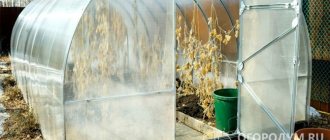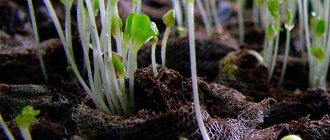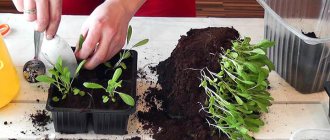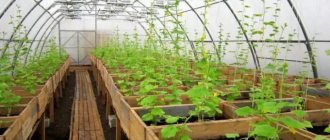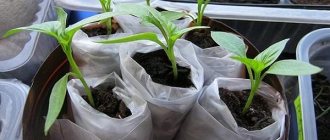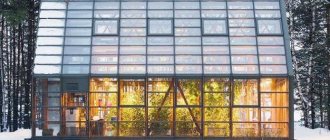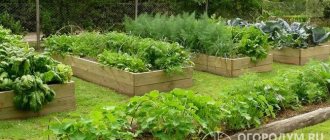A greenhouse near the house is an indispensable attribute of any garden plot. Vegetable growers are racking their brains on how to properly place plants inside so that there is enough space for everyone. The possible proximity of crops, their replacement, ease of caring for them and other important things are taken into account. But recently, what it looks like from the outside has become very relevant. Modern summer residents value every piece of land, and therefore attach great importance to the appearance of the shelters and plant flowers around the greenhouse to make the space look beautiful.
Flowers around the greenhouse: what to plant to make it beautiful and convenient
A greenhouse near the house is an indispensable attribute of any garden plot. Vegetable growers are racking their brains on how to properly place plants inside so that there is enough space for everyone. The possible proximity of crops, their replacement, ease of caring for them and other important things are taken into account. But recently, what it looks like from the outside has become very relevant. Modern summer residents value every piece of land, and therefore attach great importance to the appearance of the shelters and plant flowers around the greenhouse to make the space look beautiful.
What to plant along the greenhouse
Around the shelters for plants, decorative shrubs with long flowering periods look very elegant: single spirea, rose bushes, low-growing hydrangeas, etc. They serve as an effective fence for buildings, while at the same time separating them from the rest of the territory. You can place stands (or pyramids) of climbing roses or clematis here. Flowers along greenhouses always attract attention, drawing attention to themselves.
Important! It is not recommended to plant ornamental shrubs too close to the greenhouse! Not all vegetable crops grow in the shade in a greenhouse.
Group plantings of proud, tall lilies look unusually elegant. They harmonize perfectly with horizontal junipers or miniature conifers placed nearby. Some landowners set up a real flower garden near the greenhouse, planting crops in tiers. Low flowers and perennials appear in the foreground, behind them (closer to the buildings) large plants rise in the background.
Flower arrangements for the garden and cottage
Beautiful combinations of flowers of various heights and colors are the central place in any summer cottage. They help to break up a monotonous environment and create an elegant design.
When creating a composition, you need to take into account that a suitable environment is important for it. It always attracts attention, so you shouldn’t place it in a place that looks unsightly. For a dacha, it is better to make a landscape-type composition, that is, use all the elements of a suburban area.
With any type of composition, two principles are used to create it - creating contrast or similarity.
For a contrasting composition, choose plants that differ sharply from each other in shape, color, and texture.
When using the principle of similarity, plants also differ, but only slightly, and the differences are stepwise. For example, a color transition is used from rich red to light red, and from there to pink.
Another important point is the size of the composition. It should become an organic part of the site, so you don’t need to make it too big or too small. A large size does not make it possible to appreciate the beauty of the flower garden as a whole, and a small one will look frivolous.
First, select the main element. It can be a tree, a tall bush on the site, or a tall flower. The composition with spruce looks very beautiful. Shrubs or perennials should be planted at different distances from it. At the same time, it is important to maintain symmetry and remember that plants with picturesque, lush crowns are not always appropriate here. Although any options are possible in a landscape composition.
There is usually only one central element in the composition; its framing is chosen in several copies. And the number of lower-level plants is not even counted; they are taken in the quantity necessary to decorate the background.
Greenhouse in landscape design
Shelter for plants can be designed according to your own taste. To decorate the space near it, a variety of available means are boldly used:
Inside (or outside) almost any thing you can find a place to plant flowers. Don’t be afraid to use clay pots, wooden cabinets, leaky buckets and old wheelbarrows - create your own unique flower bed near the greenhouse.
This entire “entourage” can be painted, supplemented with twine, figurines, lanterns and lamps. Nicely designed paths nearby can provide a striking frame for the greenhouse. Some gardeners use mobile structures in boxes: you can change them in places, place them linearly or on ledges. They have racks attached to which string or wire for plants is pulled. You can create original compositions from these flowers around the greenhouse.
Decoration around the greenhouse
An ordinary shelter for plants can be transformed into a bright and unusual decoration of the site. Even the oldest and most unsightly building can be painted, the path to the entrance laid with stones or broken bricks, and the windows and roof decorated in an unusual way. Some craftsmen specially age the windows and doors, turning the building into a real vintage hut.
A special role in this case is given to green spaces. What can be planted around a polycarbonate greenhouse? A variety of crops are suitable for this, but taking into account their future placement. When creating a flower garden, it is important to take into account certain nuances:
When choosing what to plant along the greenhouse, be sure to take into account the illumination of the area. The most sun-loving and capricious pets are placed in the flower garden on the eastern side of the greenhouse. The shaded side of the building will be enlivened by representatives of shade-tolerant crops.
Selected and placed correctly, they will look elegant and stylish.
It is important to consider the specific flowering time of each plant. They are selected in such a way that new species bloom to replace those that have faded. When planting plants, the timing of their biological maturation is taken into account.
Primroses in the beds will be replaced by early flowering summer plants, then the time will come for summer-autumn crops. Thanks to this, the flower beds are filled with opening buds gradually, maintaining their decorative effect for a long time. Perennials and annuals can grow side by side on the same ridge. Such compositions require minimal care.
Classification of border perennials
Planting border perennials is more advantageous in terms of labor costs when caring for them. Border perennials, once planted, can grow for several years without replacement. The specific type is chosen in accordance with the intended purpose when designing the composition.
Rules for choosing perennials for forming a border
Plants for the border according to the height of the bush are divided into:
Border perennial flowers will grow in one place for more than one year, so it is better to draw a color plan of the future flower bed or ridge before planting. At the same time, take into account the timing of the beginning and end of flowering.
What qualities of border perennials still need to be taken into account:
Perennial flowers and shrubs for borders
Most often, low-growing shrubs and other perennial border plants are planted to create a border. A living border looks brighter and more original in comparison with stone and bricks. Photos and names of plants will help you make your choice.
Agapanthus
This perennial has abundant foliage and inflorescences with a pleasant aroma. The plant does not require specific care.
Balsam
Another name for balsam is flame, which is associated with active and long-lasting flowering. The plant has many species, both annual and perennial.
Periwinkle
The leaves of periwinkle are distinguished by their incredible strength and vitality: their fresh appearance is maintained even under the snow.
Heather
Heather blooms in mid-summer, but the bush will show its full beauty in late autumn. The first frost will change the color of its leaves from green to burgundy and yellow.
Dianthus pinnata
The perennial pinnate carnation lays a leafy stem in the first year after planting, and begins to bloom in the second year of life.
Heuchera parviflora
Most types of heuchera are unpretentious, but this does not apply to soil requirements and lighting. The plant is contradictory: moisture-intensive and loose soil, bright sunlight and partial shade at midday.
Avens
Gravilat is so frost-resistant that in areas with mild winters warmer than minus 18, it does not change the color of the leaves until the new season.
Dicentra
The shape of the dicentra bush is similar to a fern, and the heart-shaped flowers, on bare shoots, hang in impressive clusters.
Tenacious
This herbaceous plant was named tenacious for its exceptional love of life and survival in extreme conditions.
Lavender
To plant lavender, it is better to choose a place illuminated by the sun, however, the flower will grow in partial shade. But in this case you won’t have to count on abundant flowering. Lavender grows well in soils with neutral acidity. We neutralize acidic soil by adding wood ash - this is also a top dressing.
Bloodroot
Of the huge variety of bush cinquefoil varieties, the most popular is Kuril bush tea, used for decorating rock gardens, borders and hedges.
Lobelia erinus
When decorating ridges and living borders, Lobelia is distinguished by its rare color. But with a lack of moisture, lobelia erinus limits growth and drops flowers.
Narcissus
Daffodils are one of the first signs of the onset of real spring. April and May are the time for daffodils to bloom. By mid-summer, the above-ground part of the plant dries out. The bulbs can be dug up to be planted again in August.
Aubrieta or aubretia
An unpretentious ground cover plant, it grows quickly, forming a living carpet, and blooms until winter, which is why gardeners love it.
Primrose
Primrose is also called primrose (prima - first). Primroses are among the first to bloom in the spring, some species in the summer.
Hosta funkia
What hostas are famous for is the leaves that form a dense bush, but hosta flowers are inexpressive. The lifespan without transplantation is impressive - up to 30 years.
Chrysanthemum
The summer season ends, and the “Queen of Autumn” - the chrysanthemum - comes into its own. Like the aster, it blooms from August until the cold weather.
Chistets woolly
This plant attracts with its original woolly pubescence. The fibers dotting the bush create the illusion of velvet. Chistets is great for creating a living border.
Japanese spirea
Spiraea is valued for its decorative properties and ability to withstand pruning. Low-growing varieties are especially good at decorating borders.
Advantages and disadvantages of border perennials
Flowers around the greenhouse: growing features
The greenhouse is a rather massive structure. Therefore, when arranging flowering beds near it (or around) it is very important to be guided by the principle of multi-tiering. In general, the flower arrangement should represent harmoniously combined plantings: from low (or creeping) representatives to large-scale, proudly towering crops.
When presented as a flat element of landscape design, multi-tiered compositions can be incredibly impressive. In such floristic groups, only the length of the stem provides the difference in height. Lush heather or rugged sedge help create a cohesive look.
The combination of large plantings with decorative foliage and low, bright perennials looks beautiful. Representatives of coniferous plants will feel great on the shady side of the greenhouse. Decorating the space around the greenhouse with decorative elements, gravel and colored pebbles will emphasize the exquisite beauty of flower plantings.
There can be a variety of flowers growing around the greenhouse - choose from the options we offer or create your own combinations so that your garden will have a blooming garden!
Source
Herbs
Perennial cereal grasses Sedge Morrow Variegata Ophiopogon flat-arrowed
foxtail pinnately
Hakonechloa
Gray fescue
Imperata
The right combinations of crops: what to plant and with what in one greenhouse to get a lot of harvest
Greenhouses have become an integral part of the life of summer residents. They help grow heat-loving crops in the middle and northern regions.
Modern industry offers its consumers structures made from a wide variety of materials - from wood to metal supports. But few people know how to effectively use a greenhouse on their site.
Advantages of growing plants in protected soil
Gardeners, when installing a greenhouse on their site, try to make maximum use of this space to plant a variety of crops in the neighborhood.
As a result, yields in protected soil are very different from those grown in open soil.
You can control the temperature and humidity inside. But even with these benefits, there are some rules.
Rules and principles of joint cultivation
Any planting is done the same way for all joint seedlings. First, the main crop is planted, then other plants are planted to it.
In this case, the most common vegetables are cucumbers and tomatoes. But they don't like close proximity. Then other vegetable crops are planted with them.
Proper placement of seedlings allows you to harvest more crops (see table of compatibility of greenhouse crops).
Crop rotation and seasonal planting: what to plant in spring, summer, autumn, year-round gardening
In order for the seedlings to produce a good harvest, low-growing plants should be planted after the main planting crop. For example, grow radishes (several types) in early April, then plant tomatoes or cucumbers after harvesting.
Early crops are planted first, then early ripening ones. And at the end of August they reach cold-resistant vegetation.
Compatibility table for greenhouse crops:
What can you use to grow tomatoes?
Tomato seedlings prefer light soil with a high calcium content. When using organic fertilizers, fertilizing is not necessary.
If tomatoes are “overfed,” instead of a good harvest, the number of green leaves will increase and the fruits will be small.
They require periodic ventilation. The culture cannot be overcooled or the temperature raised as for watermelons or melons. Water generously, but only to the very roots.
According to all these requirements, tomatoes will be good neighbors for early ripening white cabbage. At the end of the greenhouse, various lettuces (headed or leafy) can grow. Radishes, green onions and parsley take root well.
Experienced gardeners do not recommend planting fennel or dill together with any varieties of tomatoes.
What crops do cucumbers go with?
Cucumbers have their own peculiarity. Planting is carried out for each region at different times.
The culture loves light and warmth, so if there is no artificial lighting in the greenhouse, this should be done in mid (late) May for the northern and central regions.
In this case, the maximum temperature outside should be +15 o C.
For southern regions, or greenhouses with lighting and heating, planting can begin in April.
In order to plant cucumber seedlings, use a one-line or two-line method.
They require abundant watering, otherwise the lack of moisture will affect their taste (they will become bitter).
If there is enough space around the seedlings, it is recommended to plant white cabbage. The following crops are considered good neighbors:
Peppers, eggplants, salad: successful combinations and the right proximity
Pepper
Peppers and eggplants are nightshades, so their proximity will not cause harm. But there is a rule according to which they should not be too close to each other.
Experienced farmers recommend digging beds as follows:
You can plant basil and onions next to them.
Cucumbers are also considered good neighbors. This crop can be used to separate the tomato and tomato beds.
Eggplant
In order for eggplant seedlings to grow faster, they are grown in a greenhouse. The culture loves moisture, a lot of sunlight and good feeding.
Seed spacing that is too short will reduce yield due to lack of sunlight. This is a very finicky plant.
| Looking for gardening equipment and tools? Cayman brush cutters for the home. Review of garden tools and equipment, reviews on the website: fermerinform.ru |
It is very picky about its neighbors. Always keeps a good distance with crops such as tomatoes or eggplants.
It gets along with tomatoes only if the tomato variety is low-growing. But it goes well with onions and melon.
Salad
Prefers exclusively organic. It grows only in rows, between which there should be a distance of at least 20 cm.
With proper care, the crop can be harvested every two full weeks.
Pairs well with a variety of greens:
Cabbage: combination with zucchini
Cabbage is an ideal neighbor for almost all types of plants. It is a moisture-loving crop and unpretentious to grow. It goes well with any plant, including zucchini.
Therefore, many cultures coexist next to it. But white cabbage attracts many harmful insects with its smell. To get rid of cutworm larvae, farmers plant dill nearby.
Its specific smell will not only repel insects, but will also improve the quality of the vegetable.
To strengthen the immune system against diseases and harmful insects, the seeds are treated with potassium permanganate or a certain chemical. drug.
Tomato bushes cope with harmful insects no worse than dill.
It is advisable to completely fence the seedlings with bushes.
The exception is red cabbage, which is best planted separately.
Kohlrabi cabbage goes well with asparagus, peas, beans and garlic.
Watermelons and melons
Melon crops require special conditions. They came to us from southern countries. And only there there are ideal growing conditions for them.
Therefore, greenhouses for them are built high, and the ovaries are suspended almost from the ceiling, but so that the cold air does not freeze the fruits.
The structure must be sealed, without cracks or crevices. The culture must be completely isolated from fungal diseases. To do this, the frame and soil are sprayed with a special Bordeaux solution or a mixture of copper sulfate.
Typically, watermelons or melons are planted when the temperature inside the room is at least 25 o C. They require a lot of light and little moisture. To prevent the greenhouse from standing idle, the entire soil is planted with early varieties of greens or radishes.
In conditions of low dampness and high temperature, eggplants and any varieties of tomatoes will be ideal neighbors. It is better not to plant cucumbers and bell peppers in such a microclimate.
Undesirable neighborhood
Tomatoes and cucumbers, as the main types of crops, can exist together only in a certain environment. But for other cultures these requirements are much more limited.
There is very limited space indoors and you have to choose what to plant first.
In this case, you should pay attention to “bad” neighbors who can spoil both the taste and fruitfulness of each other.
Hot peppers are bad neighbors for any crop. With their pungency, they will spoil the taste of any plant during pollination.
| Interested in gardening? Dubovsky Pink grapes - the best grape varieties, review and reviews. Review of garden tools and equipment, reviews on the website: ProOgorod.com |
Therefore, they should be separated from other seedlings, or take risks if you like unusual tastes in vegetables.
Tall crops that are planted after the base varieties cannot withstand competition and will “crush” other plants.
Those who like drafts or water should not be planted with watermelons and melons.
Layout of a greenhouse with combined crops
All beds should be comfortable and as efficient as possible. Usually they are divided into 2 pieces. (70 - 80 cm wide), provided that the width of the greenhouse itself is 1.8 - 2 m.
The passage between them is 40 cm. It is covered with sand, crushed stone or tiles. This is done for convenience so that the farmer does not slip on the ground during watering or other work related to soil moisture.
On both sides, all ridges are fenced with boards, slate or other similar material so that the earth does not spill between the rows.
If the greenhouse is 3 to 3.5 m wide, the ground is divided into 3 strips with two paths. The side rows are placed along the long sides of the structure. The width is adjusted to the type of crops that will be grown on it.
The central bed is usually double. It, depending on what grows on it, reaches up to 1.5 m.
Placement of seedlings, planted plants and growing crops
The most basic parameters when building a greenhouse are:
Given all these principles, it will be very difficult to accommodate diverse cultures. Especially if the area is small.
Light-loving crops are located on the south side. And plants that prefer drafts are near windows or vents.
In closed ground, all plants alternate along a decreasing trajectory.
Starting from the tops and ending with the roots (cabbage - cucumbers (tomatoes) - radishes (carrots, etc.)).
For large greenhouses, all plants are arranged according to the principle of growth. Those. tall crops are planted in the center, and then they begin (in descending order) to switch to medium-growing and low-growing varieties. So that no one blocks the lighting.
And the infected culture spreads its infection to healthy species.
Green manure plants: what are their benefits?
Green manures are plants that are grown for one purpose - to fertilize the soil. For greenhouses, this is an ideal option, given that the soil inside is in constant use.
Therefore, in order to restore their qualities, it is necessary either not to use the soil for 3-4 seasons, or to plant them with green manure. These include the following crops:
Green manure is planted starting in spring according to the following scheme:
Useful tips from experienced summer residents
Experienced summer residents share their advice through online communities.
A greenhouse is a special room where a microclimate is formed that can maintain ideal conditions for growing various plants.
Unlike open ground, inside you can control the temperature, humidity, and soil composition. But due to the limited area, crops have to be planted nearby. Not all of them get along with each other. Then we need to look for a compromise between plants in order to reap a good and tasty harvest.
Factory
Manufacturers have tried to take into account the most diverse needs of gardeners and gardeners.
As a result, buying a greenhouse of any size and shape is not a problem. You can buy a ready-made greenhouse. Compact, roomy shelving will certainly come in handy for city dwellers: seedlings need to be hardened off, but the usable space is limited. An umbrella will reliably protect even well-grown bushes of tomatoes, peppers and eggplants from returning frosts. Models for any needs Glass-wooden dandies will definitely decorate the garden, but they cost a lot, and you can’t call them roomy, and storing them is problematic (what other shortcomings can you find to make them disappear? a burning desire to buy one for yourself?!).
Smart greenhousesChoose a ready-made greenhouse or components
The use of greenhouses in landscape design
Growing heat-loving vegetables is one of the main and favorite activities of summer residents. Spending a lot of effort on this, every gardener dreams of getting a good harvest, regardless of weather conditions. To achieve this goal, it is almost impossible to do without installing a greenhouse, since it reliably protects the planted plants from the negative influence of the external environment and creates an improved microclimate for their development. However, modern summer residents and gardeners are increasingly attaching importance to the aesthetic appearance of both the greenhouse itself and the area on which it is located.
Role in landscape design
When planning to purchase or build a greenhouse on your property, you can implement ideas that will help it become a real highlight of your backyard landscape. With the help of individual design, you can create a full-fledged landscape element from a greenhouse that will harmoniously fit into the overall picture of the site. For people with financial resources, transformable designs with creative lighting, assembled using a combination of non-standard materials, are available. In early spring they are used for growing vegetables and herbs, and in summer - as a gazebo for relaxation.
For people who are accustomed to embodying their ideas with their own labor to make their garden area aesthetically pleasing, we can recommend several options for ideas for greenhouse structures that are not particularly difficult to bring to life, using improvised or available materials for their construction.
Greenhouses intended for business cannot fit harmoniously into the landscape. They are installed in separate special areas or in the backyard. In this case, all that can be done to improve it is to separate it from the main area with a hedge or decorative fence that will not cast a shadow on it. At the same time, the last thing people pay attention to is the appearance of the shelter for plants; when choosing it, completely different criteria come to the fore, aimed at increasing the productivity of labor and money expended.
Rules for creating compositions
An important condition when creating flower arrangements is to use predominantly low-growing plants, so that over time you do not end up with a hedge instead of a border. That is why the shortest ones are planted closer to the edge.
A few simple rules will help you create a flower border when decorating paths on your site:
Garden paths are decorated with edgings, mixborders and borders using a wide variety of plants, and without studying the characteristics of growing each of them, a positive result is not guaranteed.
Source
Types of greenhouses
The modern market offers many options for greenhouses in terms of shape, design, material from which they are made, light transmission, compliance with a particular type of operation, etc. There are a number of nuances that need to be taken into account when making a choice.
There is another important nuance in choosing a covered vegetable garden - they can be collapsible or stationary. It makes sense to install the latter if you rarely visit your dacha. Such a structure cannot be dismantled and stolen. In cases where you are constantly at the dacha only in the summer, it is more practical to choose collapsible models for a similar reason. To decide which one to install on your site, you need to decide on the location and purpose of use.
What should be the width of the bed?
3 Make beds of equal length and width. For experienced gardeners, they measure nine, four and a half or three meters long. And the optimal and most “fashionable” width among specialists today, which allows you to comfortably cultivate the land, is 45 centimeters for all crops.
Interesting materials:
Is it possible to paint with watercolors on whatman paper? Is it possible to give birth to a child with chronic glomerulonephritis? Is it possible to give birth in Lapino for free? Is it possible to have a mercury thermometer on an Aeroflot plane? Is it possible to transfer money from an asset to a card? Can files be used to process curved surfaces? Can I insert the lenses into the frame myself? Is it possible to plant pansies in an apartment? Is it possible to plant eggplants next to potatoes? Is it possible to plant hydrangea in July?
Choosing a location for installation
To realize aesthetic ideas, the construction of a greenhouse structure should be treated as an architectural object. The key factor when choosing a location for its installation is the maximum level of illumination. This means that during daylight hours it should not be shaded by buildings or plantings. To achieve maximum illumination, experts advise positioning the greenhouse so that the ends are located in the west and east. The normal place for a greenhouse is considered to be one that is partially shaded only in the morning (or at the height of the day's heat), ideal - if there is no shade at all.
When determining the location of the vegetable shelter, you should take into account whether the vegetables will be grown in winter or early spring, when natural light will not be enough for plant development. Then the presence of the necessary communications must be in suitable proximity. At this stage, you should also worry about the convenience of watering and heating (if it is planned).
Also, when determining the future location of the greenhouse, experts advise choosing a place protected from the winds. A good barrier for them can be low (2 m) fences or hedges, which ideally should be located at a distance of at least 7–7.5 m.
To place a greenhouse, you need to take into account the topography of your garden plot, as well as the type of soil on which it will be located. The area should be flat (it’s good if it’s a natural hill) and without stagnant water. It is easier to find a good place to build this structure when initially planning the site than to fit its location into an existing landscape.
It is worth noting that small greenhouses made of glass or polycarbonate, located near the southern wall of the house, are especially popular among gardeners. It is difficult to overestimate the convenience of such a structure. It is always protected from the wind and well lit. It is easy to organize heating and watering here if desired.
Recently, more and more often in garden plots you can find domed greenhouse structures that fit very effectively into the backyard design. They are more functional and economical. They are made of glass or polycarbonate.
Individual
I’ll pay tribute to fashion: first of all, I’ll show you the most stylish mini-greenhouses - glass cloches (domes). Thanks to their decent weight and wide base, they are stable, equipped with a comfortable handle, and just very beautiful! But I don’t see them in my garden: to cover my horde of seedlings, I will need a wholesale purchase of glass beauty, which will cost a considerable amount. How long will it take to arrange and remove these domes, and where to store them? No, the garden will do without them. It’s a pleasure to put a couple of pieces in the flower garden under the window. Fashionable mini-greenhouses Although, I must admit, I wouldn’t refuse some models - I like the vintage style. Charming cloches in the Victorian style Simpler models are also good, besides ideal for covering seedlings that quickly acquire large leaves - pumpkins, zucchini. An excellent option for covering scattered plantings. A budget alternative cloche is an ordinary jar. Of course, it is not so stable and is suitable only at the early stage of seedling development. Squeezing grown plants into a narrow neck is not only inconvenient, but also dangerous - how long will it take to break the fragile stems? Budget cloche for young plants For lack of anything better, you can make a greenhouse from bottles, carboys and canisters. The downside is that they are light, especially the first two options, and are inferior in beauty to factory glass “hats”. But there is also an advantage - ventilation: when it’s cold - the lid is in place, when it’s hot - take it off, and that’s it. Greenhouses from plastic containers I definitely won’t build a greenhouse over each plant - it’s too troublesome. But sometimes they can be a way out of a difficult situation: for example, if there is no material to cover an entire bed or protection is required for single specimens.Individual greenhouses
How to decorate a place near greenhouses
A covered vegetable garden will look beautiful against the backdrop of lawn grass or specially equipped paths. It looks impressive on decorative foundations made of wood or brick. The space around the greenhouse can be successfully decorated using improvised means; anything will do: old garden tools or furniture, inside of which there is space for planting flowers. You can use old wheelbarrows, buckets, clay pots, cabinets, etc. They will look impressive when supplemented with any elements - flowers, figures, twine, etc.
How to make beautiful beds near greenhouses
Recently, gardeners often decorate the space around greenhouses with artificial paths made from scrap or purchased materials. It’s a good idea to use designs from boxes of various configurations - linear, stepped, etc., here the flight of imagination is unlimited.
They are convenient because the arrangement of the boxes can be moved at any time according to your wishes or needs and you can create any composition, the main thing is that such a structure is not low (up to 1.8 m) and does not create shading for the plants in the greenhouse. Often, the areas around greenhouses are equipped with stationary artificial beds made of wood, stone or brick against a background of lawn grass and man-made paths made of different materials.
What can you plant?
As a rule, annual flowers are planted in decor made from old things. Sometimes they are supplemented or replaced with artificial ones. Indoor plants also look good in it, but here you need to take into account their compatibility with direct sunlight. You can plant whatever you want or need in the beds: flowers, herbs, vegetables, berries.
Long-flowering shrubs will look beautiful near your greenhouse: low-growing hydrangeas, spirea in solo planting, roses, etc., while they will seem to separate it a little from the main area. It is good to place pyramids or stands of clematis or climbing roses near the greenhouse, which will attract attention to themselves. Group plantings of tall lilies will look impressive. You can dilute them with dwarf species of conifers or horizontal junipers.
Lower-growing perennials and flowers should be placed in the foreground on the second tier from the greenhouse, for which planted tall plants will create a beautiful background. This will create a complete finished landscape picture. Often shelters for vegetables are placed separately, simply by planting a lawn around them or installing artificial turf around them.
In this situation, there are no restrictions on the flights of your imagination. You can resort to the help of professionals or do this design yourself; fortunately, on the Internet you can find a lot of interesting ideas and information on how to implement them. The main thing when arranging a greenhouse design is to follow the principles of sufficient lighting, protection from winds and shelter for your vegetables or flowers.
Autumn
Just a few words about greenhouses for autumn growing - they are no less important than spring ones! Surely most summer residents already have experience in arranging them, but it never hurts to consider new ideas - what if they come in handy? Greenhouses for autumn growing I liked a solid tent over the garden bed, but it is unlikely to appear on my site. I build greenhouses myself, since choosing the type of structure is a bone of contention in our family. The husband needs to build to last, thoroughly, on a large scale. And I prefer temporary shelters, which he really doesn’t like. I can’t handle arranging the tent alone, but I’m afraid to involve my husband: he will definitely find it flimsy and will be asked to strengthen the structure. It’s impossible to imagine what this will result in in the end. Options for autumn greenhouses What kind of greenhouses do you have for seedlings and growing, tell us! Ideas for practical and easy-to-arrange structures are especially welcome, but others will not be out of place! These publications on the topic will probably prove not only interesting, but also very useful:
- How and from what to build a simple greenhouse at the dacha
- Greenhouse for spring seedlings
- Do-it-yourself greenhouse at the dacha
- Express greenhouse made from scrap materials
- What is the best way to make a greenhouse and what to plant in it?
- Raised bed and mini-greenhouse in one bottle
- Greenhouse for a high bed: fast, convenient and reliable
- Early start: choosing material for a greenhouse or greenhouse
- The most optimal covering material for greenhouses and greenhouses. Three in one: protection, air, warmth
- No wind, no cold - no problem for seedlings!
- Another interesting mini-greenhouse
Photos from pinterest.com were used in preparing the material.
Experiments around the greenhouse
I recently wrote about experiments inside a greenhouse - how we make a comfortable greenhouse for ourselves through trial and error. Everyone has their own needs and requirements, and therefore their ideals are different. We create our ideal
